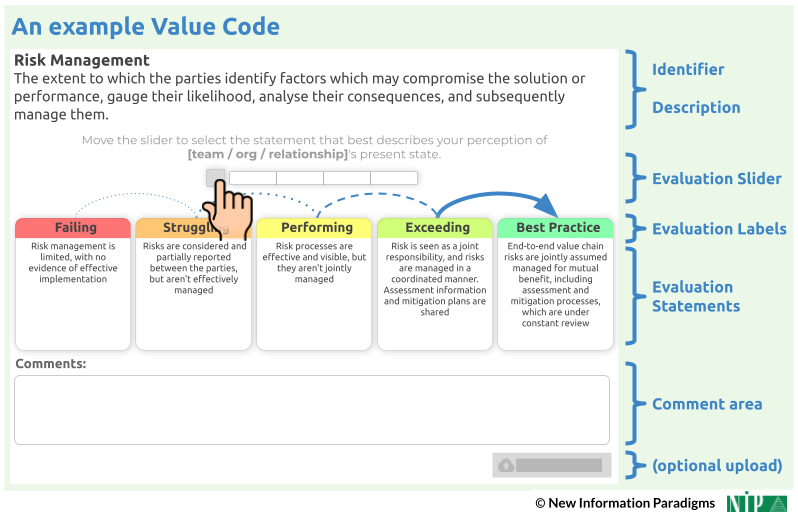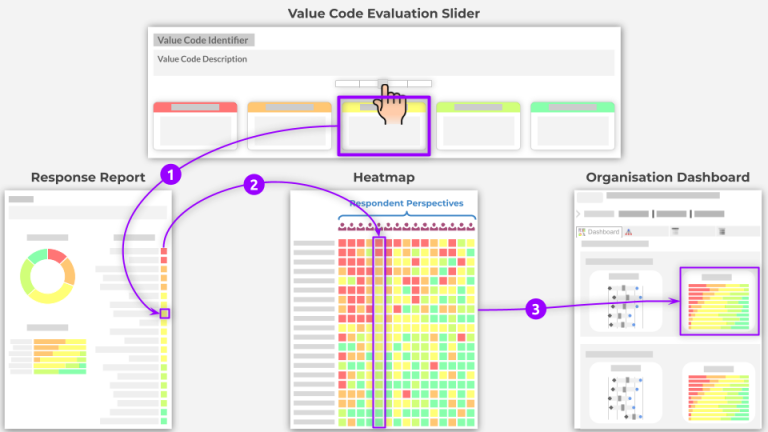Here we’ll briefly describe how to write a Value Code.
This is a deliberately simple overview to help you get started, there’s more detail in our Beginners Guide to Writing Value Codes and our glossary of Value Code terminology.
We also have Value Code Templates / Examples available to download.
Step 1: Understand the anatomy of a Value Code and why they’re structured the way they are
A Value Code consists of:
- short Identifier
- a more in-depth description
- (optional) help text
- five progressive Evaluation Level Labels
- five Evaluation Statements for each level
The five Evaluation Statements range from an assertive description of what ‘barely acceptable’ looks like, through to an assertive description of ‘what good looks like’, with three more descriptions of progressively more constructive stages in between.
They are typically presented to people at the point of evaluation in the following format:

After evaluation, the distinct evaluation level colour scheme is used to present summary and analytical reports back to respondents and team leaders.
Each of the Value Code’s five levels for its evaluation statements has a designated colour. The 5 colour levels are: red, amber, yellow, lime, green.
Those same colours are used in summary and analytical reporting, in various bar charts, pie charts and heatmaps.
Below you can see how the colour associated with a particular evaluation statement selected by a respondent forms part of their individual response report, and also how that contributes to reports that summarise responses from large numbers of people.

You can hopefully start to see how the structure of a Value Code is a generative constraint that enables a standard for evaluating things that matter and managing value.
Step 2: Factor out the things that matter and draft your Value Codes
Focus on a particular aspect of a thing that matters – not a set of things.
Each Value Code should offer clear, actionable insights.
When presented with a list of things that matter, themes or key areas, it’s important not to directly map each one to a single Value Code. Things that matter, themes or key areas can often encompass multiple facets or dimensions, and each of these might warrant its own distinct Value Code. As you analyze a thing that matters, theme or key area, break it down into its core components or aspects to enable comprehensive and nuanced evaluation.
Write a concise draft Value Code Identifier – a short label, ideally limited to no more than 2 or 3 words or 30 characters.
Don’t worry about your Evaluation Level Labels at this stage. You will want to aim for consistency across a set of Value Codes, but for now you can leave them as “1 to 5” or “Red to Green”.
Draft your Evaluation Statements beginning with ‘level 1’ and ‘level 5’ – it’s often easier to describe the extremes of ‘barely acceptable’ and ‘what good looks like’ before filling in the gaps between.
Each Evaluation Statement should ideally be limited to no more than one or two sentences, or about 25 words.
Once you’re happy with your five Evaluation Statements, write your Value Code Description – ideally limited to no more than one or two sentences, or about 25 words.
We recommend that you begin your Value Code Description with the words “The extent to which” followed by a summary of the detail contained in the fifth Evaluation Statement.
Optionally capture any additional information that might be needed for people evaluating or reviewing reports as ‘Help Text’ (this could include term definitions, links to related material, etc).
Evaluation Statement Drafting Checklist:
In general, we advise that you:
Step 3: Review, edit and finalise a set of Value Codes
Take time to review your Value Codes.
You should flick back and forth between the Evaluation Statements to ensure that they are progressively sequenced and that each one is clearly distinct.
Your Evaluation Statements should be written in a way that the reader should not be confused as to which Evaluation Statement to select. It should not be possible for someone to reasonably be able to select more than one Evaluation Statement at a time.
Avoid unhelpfully vague Evaluation Statements that could potentially be confused because both could simultaneously be true (e.g. “We are improving [x]” and “[x] is incomplete”).
Avoid using Evaluation Statements that include multiple things that make it difficult for someone to choose one over the other. For instance, it could be difficult for someone to choose between the Evaluation Statements “Documents are not clearly written and not easily accessible” and “Documents are clearly written and are easily accessible”, if their documents are not clearly written but are accessible – in this case it may be worth splitting into two separate Value Codes.
Review your set of Value Codes to ensure each is distinct and they do not overlap.
You should group Value Codes into appropriately named ‘Sections’. We advise limiting a diagnostic to about 20 Value Codes spread evenly over about 5 Sections. Sections should contain more than two Value Codes.
When deriving Value Codes from a list of things that matter, themes or key areas, aim for an optimal structure that ensures comprehensive evaluation without overwhelming respondents. As a guiding principle, aim for approximately 20 Value Codes distributed across roughly 5 sections. This structure balances depth and breadth, allowing for a detailed yet manageable evaluation. While there’s flexibility in this number (40 or more Value Codes may be required to cover all the things that matter), try to maintain a relatively even number of Value Codes across sections.
